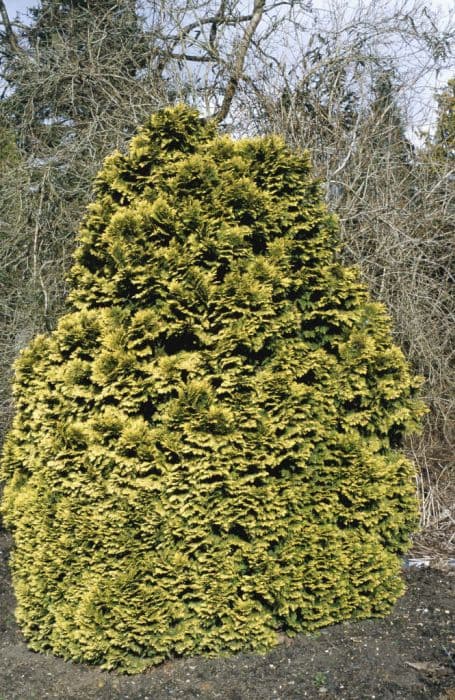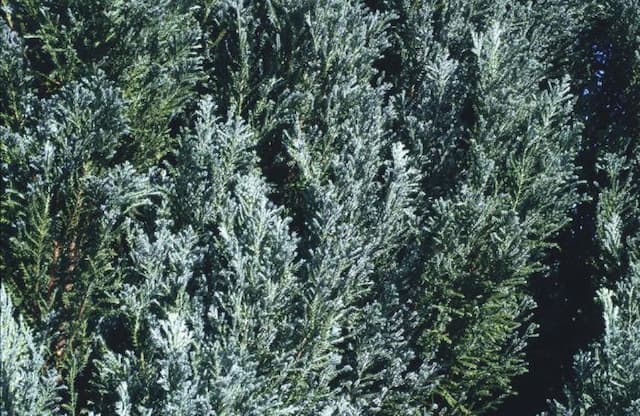Chinese juniper Juniperus chinensis 'Obelisk'











ABOUT
Juniperus chinensis 'Obelisk' is commonly known as the Chinese juniper 'Obelisk'. This plant has a distinctive, upright growth habit, forming a narrow column. The foliage of the Chinese juniper 'Obelisk' is dense and comprised of needle-like leaves that can have hues ranging from rich green to a bluish-green, depending on the season. The texture of the leaves is fine, contributing to the plant's soft appearance despite their prickly nature. The Chinese juniper 'Obelisk' produces small, fleshy cones that resemble berries, which are typically blue or blackish in color. These "berries" are often attractive to birds and other wildlife, serving as a food source. The bark is relatively smooth with a grayish-brown color, which can become more furrowed and textured as the plant matures. Overall, the Chinese juniper 'Obelisk' presents a compact and elegant form, making it a popular choice for vertical accents in garden designs and landscapes.
About this plant
 Names
NamesFamily
Cupressaceae
Synonyms
Chinese Juniper, Obelisk Juniper
Common names
Juniperus chinensis 'Obelisk'.
 Toxicity
ToxicityTo humans
Chinese juniper is not generally considered highly toxic to humans, but consuming parts of the plant, particularly the berries, can cause mild gastrointestinal upset if ingested in large quantities. This might include symptoms such as stomach pain, nausea, vomiting, or diarrhea. As with all plants, it is a good practice to avoid ingestion and to keep them out of the reach of children who might be tempted to eat them.
To pets
Chinese juniper could potentially cause mild gastrointestinal upset in pets, such as dogs and cats, if they consume parts of the plant. Symptoms of such an occurrence might include vomiting, diarrhea, or abdominal pain. It is generally advisable to prevent pets from consuming plants, as individual animals might have different reactions or sensitivities.
 Characteristics
CharacteristicsLife cycle
Perennials
Foliage type
Evergreen
Color of leaves
Green
Height
10-15 feet (3-4.5 meters)
Spread
2-3 feet (0.6-0.9 meters)
Plant type
Shrub
Hardiness zones
4-9
Native area
China
Benefits
 General Benefits
General Benefits- Landscape Aesthetics: Offers an elegant vertical accent with its narrow, columnar shape, enhancing formal garden designs.
- Low Maintenance: Requires minimal care once established, with infrequent need for pruning or watering.
- Drought Tolerance: Highly resilient in dry conditions, making it suitable for xeriscaping or drought-prone areas.
- Cold Hardy: Can withstand cold temperatures, making it an excellent choice for cooler climates.
- Pest Resistance: Generally resistant to pests and diseases, reducing the need for chemical treatments.
- Year-Round Interest: Retains its foliage all year, providing continuous greenery and structure to the garden.
- Wildlife Habitat: Provides shelter for birds and other fauna, which can enhance local biodiversity.
- Privacy Screen: Effective as a natural screen or hedge to add privacy to outdoor spaces.
- Soil Erosion Control: Its root system stabilizes the soil, helping to prevent erosion on slopes and banks.
- Versatility in Landscaping: Can be used in a variety of settings such as formal gardens, topiary, and as a foundational plant in mixed borders.
 Medical Properties
Medical PropertiesThis plant is not used for medical purposes.
 Air-purifying Qualities
Air-purifying QualitiesThis plant is not specifically known for air purifying qualities.
 Other Uses
Other Uses- Woodworking and Carving: The dense and aromatic wood of juniper can be used for detailed woodworking and carving projects, making small decorative items or novelties.
- Bonsai Cultivation: 'Obelisk' is suitable for bonsai due to its slow growth habit and attractive foliage, making it a favorite among bonsai enthusiasts.
- Garden Sculptures: Its narrow, upright growth habit makes juniper an excellent living ‘sculpture’ in minimalist or contemporary garden designs.
- Privacy Screening: Plant in rows or clusters, 'Obelisk' can function as a narrow, evergreen privacy screen that requires minimal space.
- Soil Erosion Control: The root system of juniper helps prevent soil erosion on slopes or in areas prone to soil loss.
- Wildlife Habitat: Provides shelter and nesting sites for birds, and the berries can be a food source for wildlife.
- Culinary Smoking: Wood chips from juniper can be used to add a distinctive flavor when smoking meats or fish.
- Theme Gardens: An ideal addition to Asian-themed gardens, where its form can complement traditional design elements.
- Windbreaks: Tall varieties like 'Obelisk' can be used to form windbreaks that protect more sensitive plants or outdoor living areas.
- Photographic Subject: Its unique shape and year-round appeal make it a popular subject for garden photographers and artists.
Interesting Facts
 Feng Shui
Feng ShuiThe Chinese Juniper is not used in Feng Shui practice.
 Zodiac Sign Compitability
Zodiac Sign CompitabilityThe Chinese Juniper is not used in astrology practice.
 Plant Symbolism
Plant Symbolism- Protection: Junipers are often thought to offer protection. This belief can be traced back to ancient times when branches were burned to ward off evil spirits or used to protect against theft.
- Purity: Due to its clean and sharp fragrance, juniper is also associated with purification. It is used in various cultures to cleanse the air of impurities or to conduct purification rituals.
- Healing: With a history of being used medicinally, the juniper plant symbolizes healing and the treatment of various ailments. Its berries and branches were commonly used in traditional medicine.
- Longevity: Juniper plants are long-lived, and as such, they embody the characteristic of longevity. They represent the life force and resilience through all weather conditions.
- Sanctuary: The dense foliage of junipers offers shelter and a safe haven for wildlife. Symbolically, they convey the concept of sanctuary and refuge for those in need.
 Water
WaterThe Chinese Juniper 'Obelisk' should be watered regularly during its first growing season to establish a deep root system. Once established, it is drought tolerant and requires less frequent watering. Generally, watering once a week with about 1 to 1.5 gallons of water should be sufficient, but this may have to be increased during periods of extreme heat or drought. It's important to ensure that the soil has good drainage and to avoid overwatering, which can lead to root rot. During the winter months, reduce watering to match the plant's reduced growth and evaporation rates.
 Light
LightThe Chinese Juniper 'Obelisk' thrives best in full sun conditions where it can receive at least six hours of direct sunlight each day. The ideal spot for this plant is an open area, away from large trees or structures that could cast shade. Although tolerant of partial shade, the juniper will have the best growth and form when planted in a brightly lit environment without obstructed sunlight.
 Temperature
TemperatureThe Chinese Juniper 'Obelisk' is hardy and can tolerate a wide range of temperatures, typically from -20 to 90 degrees Fahrenheit. The ideal temperature range for this juniper is between 60 and 80 degrees Fahrenheit, which promotes healthy growth. It's a resilient plant that can withstand cold winter temperatures, but it is important to provide protection from harsh winds that can cause desiccation in the foliage.
 Pruning
PruningPruning the Chinese Juniper 'Obelisk' helps maintain its natural shape, control size, and promote dense foliage. It's best to prune in late winter or early spring before new growth starts, but light pruning can be done throughout the growing season. Pruning should be done sparingly as junipers do not regenerate from old wood; always leave some green foliage on any branch you prune.
 Cleaning
CleaningNot needed
 Soil
SoilChinese Juniper 'Obelisk' thrives in a well-draining soil mix, preferably with equal parts of loamy soil, coarse sand, and peat. Aim for a slightly acidic to neutral pH, ideally between 5.5 and 7.0, to ensure optimal growth.
 Repotting
RepottingChinese Juniper 'Obelisk' typically requires repotting every two to three years to prevent root-bound conditions and to refresh the soil nutrients. Younger plants may need repotting more frequently, while mature specimens can be repotted less often.
 Humidity & Misting
Humidity & MistingChinese Juniper 'Obelisk' is best suited to outdoor conditions where it can tolerate a wide range of humidity levels. As a drought-tolerant plant, it does not require high humidity and will thrive in average atmospheric conditions without special humidity requirements.
 Suitable locations
Suitable locationsIndoor
Keep Chinese Juniper 'Obelisk' in bright light, with cool temps.
Outdoor
Plant in full sun, ensure good drainage, hardy shrub.
Hardiness zone
4-9 USDA
 Life cycle
Life cycle'Obelisk' Juniper (Juniperus chinensis 'Obelisk') begins its life as a seed, which under suitable environmental conditions germinates and develops into a seedling. As the seedling grows, it enters a vegetative stage, developing a strong root system, foliage, and the characteristic upright form. Over several years, it matures into an adult plant, exhibiting a narrow columnar habit with dense, blue-green foliage, and can reach up to 15-20 feet tall. The adult 'Obelisk' Juniper is coniferous and produces cones; male plants bear small pollen cones, while female plants produce berry-like cones called juniper berries, which can be pollinated by the wind. After pollination and fertilization, these berries develop seeds, completing the reproductive cycle. The plant then continues to grow and can live for many decades, assuming optimal growing conditions are met.
 Propogation
PropogationPropogation time
Early Spring
The most common way to propagate the Chinese Juniper 'Obelisk' is through cuttings. The best time for taking cuttings is during the summer when the plant is actively growing. To propagate, select a healthy branch and cut a piece about 4-6 inches (10-15 cm) long, ensuring there are at least two sets of leaves. The lower set of leaves should be removed, and the cut end can be dipped in rooting hormone powder to facilitate root growth. The cutting should then be planted in a mix of peat and perlite, ensuring good contact between the cutting and the medium. It is essential to maintain high humidity and consistent moisture levels without making the soil waterlogged. Roots typically develop within a few weeks, after which the new plant can gradually be acclimated to less humid conditions.









